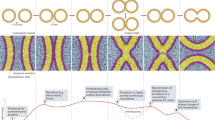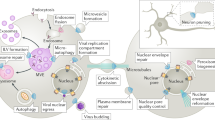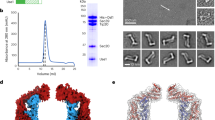Abstract
Membrane-enveloped vesicles travel among the compartments of the cytoplasm of eukaryotic cells, delivering their specific cargo to programmed locations by membrane fusion. The pairing of vesicle v-SNAREs (soluble N-ethylmaleimide-sensitive factor attachment protein receptors) with target membrane t-SNAREs has a central role in intracellular membrane fusion. We have tested all of the potential v-SNAREs encoded in the yeast genome for their capacity to trigger fusion by partnering with t-SNAREs that mark the Golgi, the vacuole and the plasma membrane. Here we find that, to a marked degree, the pattern of membrane flow in the cell is encoded and recapitulated by its isolated SNARE proteins, as predicted by the SNARE hypothesis.
This is a preview of subscription content, access via your institution
Access options
Subscribe to this journal
Receive 51 print issues and online access
$199.00 per year
only $3.90 per issue
Buy this article
- Purchase on Springer Link
- Instant access to full article PDF
Prices may be subject to local taxes which are calculated during checkout





Similar content being viewed by others
References
Söllner, T. et al. SNAP receptors implicated in vesicle targeting and fusion. Nature 362, 318–324 (1993).
Weber, T. et al. SNAREpins: minimal machinery for membrane fusion. Cell 92, 759–772 ( 1998).
Rothman, J. E. Mechanisms of intracellular protein transport. Nature 372, 55–63 (1994).
Pelham, H. R. SNAREs and the secretory pathway-lessons from yeast. Exp. Cell Res. 247, 1–8 ( 1999).
Parlati, F. et al. Rapid and efficient fusion of phospholipid vesicles by the alpha-helical core of a SNARE complex in the absence of an N-terminal regulatory domain. Proc. Natl Acad. Sci. USA 96, 12565 –12570 (1999).
Nickel, W. et al. Content mixing and membrane integrity during membrane fusion driven by pairing of isolated v-SNAREs and t-SNAREs. Proc. Natl Acad. Sci. USA 96, 12571–12576 (1999).
Chen, Y. A., Scales, S. J., Patel, S. M., Doung, Y. C. & Scheller, R. H. SNARE complex formation is triggered by Ca2+ and drives membrane fusion. Cell 97, 165–174 (1999).
Parlati, F. et al. Topological restriction of SNARE-dependent membrane fusion. Nature 407, 194–198 (2000).
Fukuda, R. et al. Functional architecture of an intracellular t-SNARE. Nature 407, 198–202 ( 2000).
Sutton, R. B., Fasshauer, D., Jahn, R. & Brunger, A. T. Crystal structure of a SNARE complex involved in synaptic exocytosis at 2. 4 A resolution. Nature 395, 347–353 ( 1998).
Hanson, P. I., Roth, R., Morisaki, H., Jahn, R. & Heuser, J. E. Structure and conformational changes in NSF and its membrane receptor complexes visualized by quick-freeze/deep-etch electron microscopy. Cell 90, 523– 535 (1997).
Fasshauer, D., Otto, H., Eliason, W. K., Jahn, R. & Brunger, A. T. Structural changes are associated with soluble N -ethylmaleimide-sensitive fusion protein attachment protein receptor complex formation. J. Biol. Chem. 272, 28036– 28041 (1997).
McNew, J. A. et al. Close is not enough: SNARE-dependent membrane fusion requires an active mechanism that transduces force to membrane anchors. J. Cell Biol. 150, 105–118 (2000).
Nicholson, K. L. et al. Regulation of SNARE complex assembly by an N-terminal domain of the t-SNARE Sso1p. Nature Struct. Biol. 5, 793–802 (1998).
Hua, S. Y. & Charlton, M. P. Activity-dependent changes in partial VAMP complexes during neurotransmitter release. Nature Neurosci. 2, 1078–1083 ( 1999).
Xu, T. et al. Inhibition of SNARE complex assembly differentially affects kinetic components of exocytosis. Cell 99, 713– 722 (1999).
McNew, J. A., Weber, T., Engelman, D. M., Söllner, T. H. & Rothman, J. E. The length of the flexible SNAREpin juxtamembrane region is a critical determinant of SNARE-dependent fusion. Mol. Cell 4, 415–421 (1999).
Weimbs, T., Mostov, K., Low, S. H. & Hofmann, K. A model for structural similarity between different SNARE complexes based on sequence relationships. Trends Cell. Biol. 8, 260– 262 (1998).
Brennwald, P. et al. Sec9 is a SNAP-25-like component of a yeast SNARE complex that may be the effector of Sec4 function in exocytosis. Cell 79, 245–258 (1994).
Aalto, M. K., Ronne, H. & Keranen, S. Yeast syntaxins Sso1p and Sso2p belong to a family of related membrane proteins that function in vesicular transport. EMBO J. 12, 4095–4104 ( 1993).
Protopopov, V., Govindan, B., Novick, P. & Gerst, J. E. Homologs of the synaptobrevin/VAMP family of synaptic vesicle proteins function on the late secretory pathway in S. cerevisiae. Cell 74, 855–861 (1993).
Gerst, J. E., Rodgers, L., Riggs, M. & Wigler, M. SNC1, a yeast homolog of the synaptic vesicle-associated membrane protein/synaptobrevin gene family: genetic interactions with the RAS and CAP genes. Proc. Natl Acad. Sci. USA 89, 4338–4342 ( 1992).
Katz, L., Hanson, P. I., Heuser, J. E. & Brennwald, P. Genetic and morphological analyses reveal a critical interaction between the C-termini of two SNARE proteins and a parallel four helical arrangement for the exocytic SNARE complex. EMBO J. 17, 6200–6209 (1998).
Gerst, J. E. Conserved alpha-helical segments on yeast homologs of the synaptobrevin/VAMP family of v-SNAREs mediate exocytic function. J. Biol. Chem. 272, 16591–16598 (1997).
Neiman, A. M. Prospore membrane formation defines a developmentally regulated branch of the secretory pathway in yeast. J. Cell Biol. 140, 29–37 (1998).
McNew, J. A. et al. Ykt6p, a prenylated SNARE essential for endoplasmic reticulum-Golgi transport. J. Biol. Chem. 272, 17776– 17783 (1997).
Newman, A. P., Shim, J. & Ferro-Novick, S. BET1, BOS1, and SEC22 are members of a group of interacting yeast genes required for transport from the endoplasmic reticulum to the Golgi complex. Mol. Cell. Biol. 10, 3405– 3414 (1990).
Nichols, B. J. & Pelham, H. R. SNAREs and membrane fusion in the Golgi apparatus. Biochim. Biophys. Acta 1404, 9–31 (1998).
Banfield, D. K., Lewis, M. J. & Pelham, H. R. A SNARE-like protein required for traffic through the Golgi complex. Nature 375, 806– 809 (1995).
McNew, J. A. et al. Gos1p, a Saccharomyces cerevisiae SNARE protein involved in Golgi transport. FEBS Lett. 435, 89– 95 (1998).
Søgaard, M. et al. A rab protein is required for the assembly of SNARE complexes in the docking of transport vesicles. Cell 78, 937–948 (1994).
Lupashin, V. V., Pokrovskaya, I. D., McNew, J. A. & Waters, M. G. Characterization of a novel yeast SNARE protein implicated in Golgi retrograde traffic. Mol. Biol. Cell 8, 2659– 2676 (1997).
von Mollard, G. F., Nothwehr, S. F. & Stevens, T. H. The yeast v-SNARE Vti1p mediates two vesicle transport pathways through interactions with the t-SNAREs Sed5p and Pep12p. J. Cell Biol. 137, 1511–1524 (1997).
Abeliovich, H., Grote, E., Novick, P. & Ferro-Novick, S. Tlg2p, a yeast syntaxin homolog that resides on the Golgi and endocytic structures. J. Biol. Chem. 273, 11719– 11727 (1998).
Fischer von Mollard, G. & Stevens, T. H. The Saccharomyces cerevisiae v-SNARE Vti1p is required for multiple membrane transport pathways to the vacuole. Mol. Biol. Cell 10, 1719 –1732 (1999).
Fasshauer, D., Sutton, R. B., Brunger, A. T. & Jahn, R. Conserved structural features of the synaptic fusion complex: SNARE proteins reclassified as Q- and R-SNAREs. Proc. Natl Acad. Sci. USA 95, 15781–15786 (1998).
Mayer, A., Wickner, W. & Haas, A. Sec18p (NSF)-driven release of Sec17p (alpha-SNAP) can precede docking and fusion of yeast vacuoles. Cell 85, 83–94 (1996).
Ungermann, C., Nichols, B. J., Pelham, H. R. & Wickner, W. A vacuolar v-t-SNARE complex, the predominant form in vivo and on isolated vacuoles, is disassembled and activated for docking and fusion. J. Cell Biol. 140, 61–69 (1998).
Söllner, T., Bennett, M. K., Whiteheart, S. W., Scheller, R. H. & Rothman, J. E. A protein assembly-disassembly pathway in vitro that may correspond to sequential steps of synaptic vesicle docking, activation, and fusion. Cell 75, 409–418 (1993).
Nichols, B. J., Ungermann, C., Pelham, H. R., Wickner, W. T. & Haas, A. Homotypic vacuolar fusion mediated by t- and v-SNAREs. Nature 387, 199– 202 (1997).
Weber, T. et al. SNAREpins are functionally resistant to disruption by NSF and αSNAP. J. Cell Biol. 149, 1063– 1072 (2000).
Rayner, J. C. & Pelham, H. R. Transmembrane domain-dependent sorting of proteins to the ER and plasma membrane in yeast. EMBO J. 16, 1832–1841 ( 1997).
Waters, M. G. & Pfeffer, S. R. Membrane tethering in intracellular transport. Curr. Opin. Cell Biol. 11, 453 –459 (1999).
Gonzalez, L. Jr. & Scheller, R. H. Regulation of membrane trafficking: structural insights from a Rab/effector complex. Cell 96, 755–758 (1999).
Mellman, I. & Warren, G. The road taken: past and future foundations of membrane traffic. Cell 100, 99– 112 (2000).
Stinchcombe, J. C. & Griffiths, G. M. Regulated secretion from hemopoietic cells. J. Cell Biol. 147 , 1–6 (1999).
Fasshauer, D., Antonin, W., Margittai, M., Pabst, S. & Jahn, R. Mixed and non-cognate SNARE complexes. Characterization of assembly and biophysical properties. J. Biol. Chem. 274, 15440–15446 ( 1999).
Yang, B. et al. SNARE interactions are not selective. Implications for membrane fusion specificity. J. Biol. Chem. 274, 5649–5653 (1999).
Novick, P. & Zerial, M. The diversity of Rab proteins in vesicle transport. Curr. Opin. Cell Biol. 9, 496–504 (1997).
Schaffner, W. & Weissmann, C. A rapid, sensitive, and specific method for the determination of protein in dilute solution. Anal. Biochem. 56, 502–514 ( 1973).
Acknowledgements
We wish to thank Dr Paul A. Marks for two decades of exemplary leadership of Memorial Sloan-Kettering Cancer Center and for creating the environment that made possible the discovery of SNARE proteins and their role in cell biology. We also thank L. Katz and P. Brennwald for plasmids, B. Brügger for help in the construction of the TLG1 clone, and T. Melia for cryo-electron microscopy of liposomes. Research was supported by an NIH grant (to J.E.R.) and postdoctoral fellowships of the Medical Research Council of Canada (F.P.), the NIH (J.M.), and the Japanese Society for the Promotion of Science (R.F.).
Author information
Authors and Affiliations
Additional information
Cellular Biochemistry and Biophysics Program, Memorial Sloan-Kettering Cancer Center, 1275 York Avenue, Box 251, New York, New York 10021, USA
Rights and permissions
About this article
Cite this article
McNew, J., Parlati, F., Fukuda, R. et al. Compartmental specificity of cellular membrane fusion encoded in SNARE proteins. Nature 407, 153–159 (2000). https://doi.org/10.1038/35025000
Received:
Accepted:
Issue Date:
DOI: https://doi.org/10.1038/35025000
This article is cited by
-
A palisade-shaped membrane reservoir is required for rapid ring cell inflation in Drechslerella dactyloides
Nature Communications (2023)
-
Parkinson mice show functional and molecular changes in the gut long before motoric disease onset
Molecular Neurodegeneration (2021)
-
SCAMP2/5 as diagnostic and prognostic markers for acute myeloid leukemia
Scientific Reports (2021)
-
A formal methods approach to predicting new features of the eukaryotic vesicle traffic system
Acta Informatica (2021)
-
Expression and Co-expression Analyses of WRKY, MYB, bHLH and bZIP Transcription Factor Genes in Potato (Solanum tuberosum) Under Abiotic Stress Conditions: RNA-seq Data Analysis
Potato Research (2021)
Comments
By submitting a comment you agree to abide by our Terms and Community Guidelines. If you find something abusive or that does not comply with our terms or guidelines please flag it as inappropriate.



